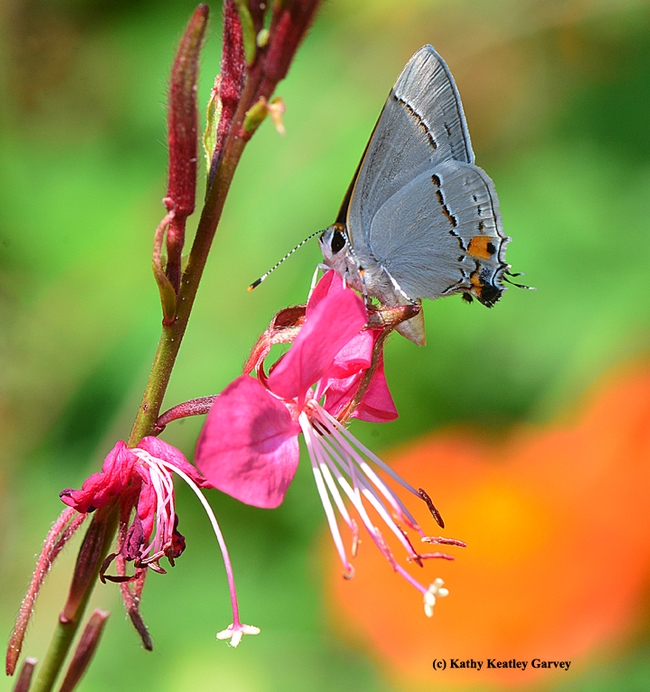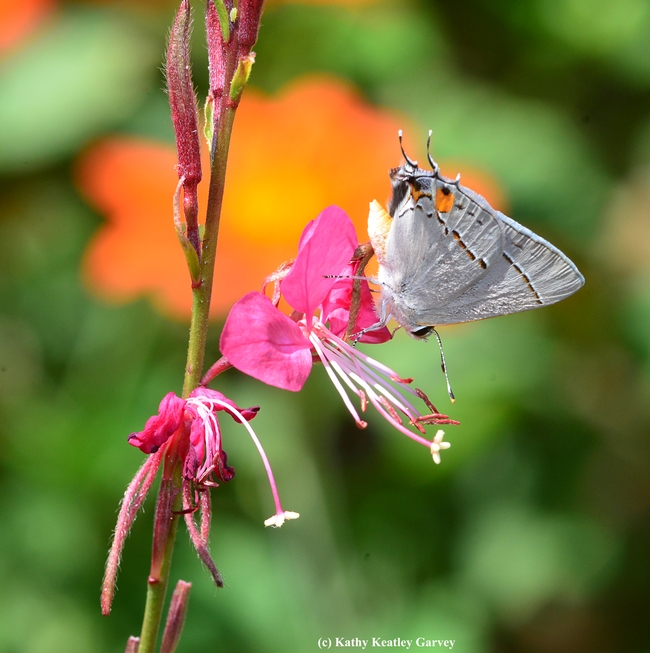Are you on a winning streak? Or a losing streak? Or somewhere in between?
The Gray Hairstreak butterfly (Strymon melinus) is always on a streak--a gray streak.
Butterfly expert Art Shapiro, distinguished professor of evolution and ecology at the University of California, Davis, writes about the Gray Hairstreak on his website, Art's Butterfly World. It's one of the many butterflies in the Central Valley that he's monitored over the past four decades.
It's most common in weedy and disturbed habitats at low elevation, Shapiro says, adding that it's "territorial and a hilltopper in suitable terrain, but does very well in towns and cities in the Central Valley. It is multiple-brooded and has a very long flight season, at sea level from February to November, but rarely seen before June in the mountains where it does not appear able to overwinter."
"Its most frequent hosts in our area are mallows, including the weedy species of Malva; legumes, including Spanish Lotus (Lotus purshianus), bird's-boot trefoil (Lotus corniculatus), white clover (Trifolium repens) in lawns, alfalfa (Medicago sativa) and many others;and turkey mullein (Eremocarpus or Croton setigerus, Euphorbiaceae)."
We recently spotted the Gray Hairstreak grabbing some nectar on our guara (Guara lindheimer). Its distinctive orange spot matched perfectly the color of the nearby Mexican sunflower (Tithonia).
Those of us joining naturalist Steve Daubert's butterfly talk and tour at the UC Davis Arboretum last September also spotted a Gray Hairstreak. The good news is that he's giving another "Butterfly Ecology Talk and Walk," sponsored by the UC Davis Arboretum, on Sunday, Sept. 14. It's free and open to the public. Participants will gather at 11 a.m. by the trellis at the California Native Plant GATEway Garden (newly-constructed garden at the Arboretum's east end, just behind the Davis Commons Shopping Center). (See the Arboretum calendar for more information and a map.)
"Last year at the Arboretum Butterfly Walk and Talk we talked about the co-evolution of the butterflies with the flowering plants, starting in the Middle Cretaceous," Daubert told us in an email. "This year we will set the scene farther back into the Mesozoic Era and talk about the origin of the advanced insect orders, including the Lepidoptera (the holometabolous insects). We will also talk about blue colors in the animals. And we will talk about butterfly gardening for folks here in the valley. We will be looking to see members of the five butterfly families commonly found in Davis."
Daubert is a molecular scientist in the UC Davis Department of Plant Pathology. In addition to writing scientific technical text, he writes short stories, illustrated with his own photographs. He blogs at threadsintheweb.com.
Attached Images:

